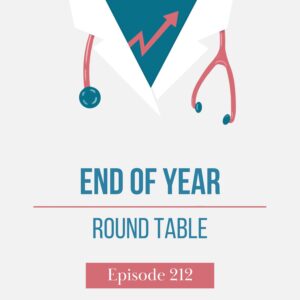Are you on auto-pilot and susceptible to routines and the rest of the world’s values? What’s most important to you in your life? There are solid steps or ways that you can take to clarify (or re-clarify) your true values.
In this episode of the Finance for Physicians Podcast, Daniel Wrenne talks about three specific exercises to help you clarify and align your values.
Topics Discussed:
- What are values? Undercurrent or true driver to measuring happiness
- Values Awareness: Day-to-day actions in alignment with what’s most important
- Results: Better decisions, confidence, happier, and feeling more purpose-driven
- Symptoms: Feeling lost, lack of confidence in decision making, and stress
- Value of Values: Believe in, maintain, and reinforce awareness of your values
- Exercise #1: Values Clarification (highlight/prioritize/summarize what’s important)
- Exercise #2: Life Map (Reflect on past; visually pointing out life’s ups and downs)
- Exercise #3: 80th Birthday: Focus on future and purpose (who/what’s important)
Links:
Values Clarification (List of Values)
Past Episode: Aligning Your Time And Money Management With Your Values
Contact Finance for Physicians
Full Episode Transcript:
Hey, everyone. Today, I wanted to talk about values and throw out some ideas for how to clarify values. I think this is a super important thing, especially for us today; we’re all just so busy. Sometimes it’s just helpful to have a concrete, quick exercise to take your time out and think through some of these really important things.
We’ll jump into that and go through that. Hopefully, the takeaway here is you have some concrete steps or exercises you can take to start to either clarify for the first time or reclarify what’s really most important in your life.
Before I jump into the exercises, I just want to clarify. I know we’ve covered this before, but values are like the undercurrent or the true driver to measuring happiness and how you’re doing.
In regards to finances, in an ideal world, you’re using your finances and all the decisions around them to propel you towards your values and get you more in alignment with those values. I think values are more important than goals. Or maybe not more important. Maybe that’s not the right word. I think values should be the underlying driver to your goals.
Values, clarification, or understanding of your values I would consider the most important step before you start to get into financial planning and making decisions in life, especially the big ones, at anything. But for the purpose of our conversation, it’s typically finances.
Anyway, values are super important. I think the key here is awareness; being aware of your values. Over time, we have a tendency to get into routines and gravitate towards autopilot or sleepwalking, or just doing the thing, and that’s where you start to lose touch with values, because values, being aware of them, you have to take your time out and be intentional.
The further you go away from it, you get into that autopilot world and that’s where you’re susceptible to the pool of the world’s values which can often be surface-level material, and are very likely not in alignment with your true values. We’re going for values awareness and what that looks like is your actions day-to-day, especially with big things, are in better alignment with what’s really most important.
It requires understanding (first of all) what’s most important because it kind of seems like you would know that, but a lot of times people aren’t just clear on that. The results of having a good awareness of your values will just lead to better decisions, confidence moving towards happiness, feeling more purpose-driven.
I would say some of the symptoms of not being aware of values would be feeling on autopilot, not as confident decisions, stress, keeping up with the Joneses, those sorts of things. Feeling kind of lost will typically be the result of pulling away from your values.
I’m going to talk through some exercises like I said. There are some general ways to become more aware of your values. First of all, you have to believe in the importance of being aware of your values and maybe admit that you’re not aware. That’s important. That’s part of my hope here is to just kind of reinforce that belief of a value, I guess the value of values, so that’s important.
You have to be intentional about it. You have to put your mind to it. You have to dedicate time for a lot of this stuff. There are some easy things that you can do like meditation, prayer, reflecting, journaling. Those are always good exercises to get into the habit of doing to help you maintain awareness of values or be more in touch with those. Those are good general habits, but what I want to talk about mainly today is some specific exercises.
Before I go through these, I think it’s important (ideally) to do these with at least another person. You don’t have to do them—you can do them solo—but I think it helps to do them especially if you’re married, have a spouse, or partner, someone you really trust. It can be very helpful to include them in this exercise. Or sometimes, people do these in small groups and that sort of thing. I think that helps. As I said, you can completely do this solo and that’s fine too. It’s just a lot of times, these kind of have to tie things together when you’re married.
First exercise. This is the most practical foundation exercise. If you’ve never done any of this stuff, it’s probably a good starting point. If you’re very logically-oriented, this is a good one to do. The focus on this is just clarifying your values as they say at the end of the day. A lot of people in therapy use this approach.
Basically, we’ll call it a values clarification exercise. I’ll link to a list of values. The first step is you don’t want to go with a blank sheet of paper. That makes it pretty hard, at least for me. I like doing it with a prewritten list of all sorts of values. Like I said, I’ll link to one.
The idea is to skim through the list of all these values and maybe you even write in some that are not listed because everybody’s going to have different values. The goal here is to highlight those that potentially would be important to you. First thing is to highlight those top values for you.
Before you do this—I should have said this in the beginning—you need to have silence. It has to be quiet. Turn the other stuff off. Put your phone somewhere else. Turn the notifications off. You have to get your mind chilled out. As best as you can turn off the other craziness that’s going on in your head. Get in the right mind space. That’s important for all of these. You have to focus. Turn off the distractions, lock the kids in the room—just kidding. Get a babysitter or do it on date night. Maybe this doesn’t sound cool on date night, but it is helpful. It can be fun with your spouse.
You have to get in the right mindset. You’re just going to skim through the list and highlight those that are your top values, then just take some time to think about each of them, and think through why this is a value to you. Maybe think about how are you doing following them. Maybe think about which one of those you would like to work on.
It seems like for me, when I’ve done this, there are the ones that are really valuable, important values for me that I’m doing a good job with, and then there are the ones where I’m not doing a good job on. That’s a different thing. It’s good to take note of all that.
Most of the time maybe you’re going to have ten or quite a few. I would try to narrow it down to maybe the top five or something and prioritize them. That’s important, to prioritize them. It’s not that easy to prioritize. It’s usually pretty difficult because they’re all important. But you want to really drill down what is the most important and then rank them. That’s going to be key for applying this in life. I’ll circle back on that.
Once you prioritize them, ideally summarize what they mean to you, like a description. This is where you can write out your value statement. I think it’s good to write this down or put it on a piece of paper to make a visual. Maybe you have a list of your top five values in order, and you have a one-sentence summary of your description of why it’s important to you. Then a list of actions that would be in alignment with that particular value. That makes it easier in the future to just glance at it and be okay, that’s an example.
Maybe family is number one so the description might be it’s extremely important for me to spend time and really connect relationally with my family and love my family, that kind of thing. Then specific actions might be like saying no to another commitment because that’s taking away from my family, or working too many hours. The action will be saying no to working too many hours. Or attending my kid’s sporting events, or for me, it’s making time to have one-on-one for each of my kids.
You can list those actions for each of these top values. Ideally, you have this takeaway here with a sheet of paper. You don’t want to get too intense with this stuff. Keep it to one piece of paper. Ideally, you have one piece of paper that you can take away from this. It lists 3–5 values in priority order, you have a summary of what it means to you and why it is important, and then a handful of actions that would be in alignment with it. You print it out and use that.
Sometimes, maybe if it’s new to you, you can put it in a place where you see it regularly. I have something like this at my desk at work or I’ll tuck it in my notebook I use for stuff or journal. I think it’s good to have it there visually. Use it and refer to it. That’s the key. That’s where it starts.
Doing these exercises will help you be a little more aware in itself. The key is when you go into life and these decisions come up, especially the big ones, you should be referring to this list.
Say you’re taking a new job, or maybe there are some sketchy financial opportunities that you have to navigate, or maybe you’re feeling you need to upgrade homes, all those sorts of things. The new job is maybe a lot better pay, so your values might be like the classic—family is number one, maybe professional is number three, then wealth is number five.
If you’re not careful, the world will tell you that a higher-paying job is always better, but you have to pull out those values and remind yourself that family is number one to me. By taking this job, I’m actually going to derail or pull out the rug under my family. They’ve gotten established, so I’m totally going to cause some pain to my family by taking this job.
If I’m honest with myself, the only reason I’m doing it is to get more money. If I really look at it, this job actually has a little bit more work commitment which is more hours away from my family, so that’s an obvious no.
If you’re not careful in this, you can get in that autopilot mode and the world is pulling you in that direction. It’s so tempting to take more money in a job offer. They maybe are not as obvious as that. There are all kinds of things that come up in life and it’s going to be helpful. Some of them are, when you get into the gray zone, they’re the ones that are the most helpful. That’s why we often make bad decisions as we go with something that is of value but is not really our most important thing. That’s pulling us in the wrong direction. That’s the first exercise.
The second exercise, I’ll give credit to Jason Waller. He wrote about this in an article and I think he’s a business coach kind of guy. The exercise is called the Life Map Exercise. This is more of a reflection on the past, which can also be a good way to understand how you got where you are today, why, and what’s most important.
This is pretty simple. You just have a blank sheet of paper and draw out your life from birth to now, life’s ups and downs in the journey and you just identify these points in time that we consider the low points and the high points, and that’s it.
There are some things that we can kind of work on or avoid. Ideally, you’re using some visual pictures or illustrations and you’re limiting the words. You don’t want to write a novel.
Ideally, you do a picture of, like a kid playing baseball or something, a dollar bill. Whatever drawing you draw represents maybe one word. An example is a lot of people do a chart of up, down, up, down. They have points and each point is in chronological order like a life experience, maybe draw a picture and put a word. It just needs to be enough to prompt you or remind you what that is about.
You want to avoid words and bullet points. You don’t want all that stuff. It needs to be visual. With this exercise, you want to stay outside of the future. This is all about the past. Once you’re done with that, it’s a good thing to tuck away in the journal, sit, and think about it.
Before you tuck it away, I think it’s good to go through some questions and thought exercises to pull out some stuff from that. Maybe look at different points you’ve identified and say, why is that so meaningful to me? How does this experience make me who I am today?
Another big question to ask is what did I learn from the lows and the highs? Sometimes we have low points that actually end up being huge take-off points, but it’s easy to forget that happened, especially the more time that goes on, so thinking about it. Or maybe the reverse. This high point actually wasn’t as great as I thought it would be. It was the catalyst for bad stuff to start happening because I was getting off-track.
The idea here is to start to see these things like maybe, for example, I was not in alignment with values or this is maybe what has gotten me to a point of where I am today and the values I have. I think that is a good exercise for reflection. Reflection is always a good thing to do every once in a while.
The next exercise is kind of more a future-oriented exercise. The exercise is called the 80th Birthday Party Exercise. I’m sure you are trying to guess what this might be. This one comes from the same guy, Jason Waller. He wrote this down pretty solidly in his article.
We’re focused on the future, we’re focused on purpose. With this exercise, as with all these, you’re going to take a time out and just get relaxed, be quiet, and you have to be focused.
The first thing is once you’re all chilled out, really try to start to imagine you’re arriving at your 80th birthday party. You’re walking in and within your imaginary visualization take a minute to look around, where are you at? What does it look like? What does your life look like? What do you look like? Let that soak in.
The next thing is to think through or imagine you’re writing a table and it’s got all the people in your life that are most important. Imagine the people and take a second to look at each person, thank them for being there, and show a little appreciation.
Also, think that they came there to be with you because they care about you. For each person, listen as each person shares gratitude and maybe talks about some of the differences you made in their life, and take in those stories and emotions with each of these people that are most important.
Take some time to reflect on what all this meant for you. Let it soak in. As you come back to the real world after you’ve thought about it for a minute, I think it’s good to write it all down, document some of your thoughts, and some of the things in addition to some of the takeaways and maybe who was there.
You can list whatever you feel is important, but some of the questions you might document would be like what was it like to be in that experience? What did your guest say about you? Was there a common theme that you took away from that exercise?
The goal is to get a little closer to your ideal life, what you want and need to get there. What this exercise, the idea is to envision yourself in that future ideal life. As you see that, it starts to give you that picture of what that looks like. You can start to think about, what do I need to do to get there? Maybe these people were saying you were there for me at the hard point, or your family and you were always supportive and whatnot.
The takeaway from this is you really start to see that game changer super important stuff. Sometimes you’re going to be I need to get on it. I’m not exactly doing what I needed to do to get there. Other times, in this area I am doing a good job and give yourself a pat in the back.
That’s the last exercise I wanted to go to. There are a bunch of these out there. There are hundreds of them. You can google it all day long. I think the key is to take a time out and spend 20 minutes or so. Work through something like this and take note of it, start to refer back to it over time, and then adjust it over time because things change.
You realize maybe something you thought was important is not as important. It will be adjusted over time. That’s where you start moving the needle. When you do this exercise upfront, it will be kind of cool to clarify and maybe emotional. You’ll feel good about it. There’s not any change instantaneously, but over time, by having that greater awareness and by referring back to it, that’s where the change happens. You’ll start to slowly move the needle and that’s what we are after.
That is all I have for today. As always, I hope you enjoyed it, and we’ll look forward to talking to you next time.









